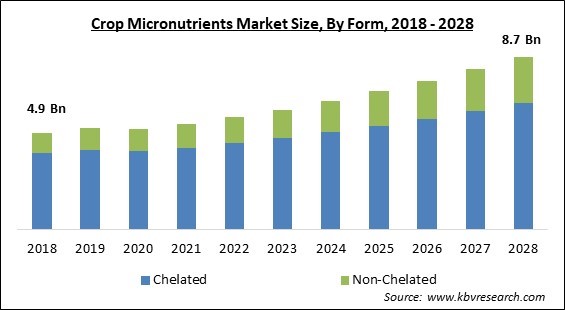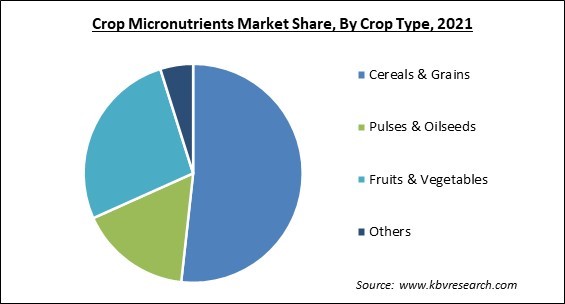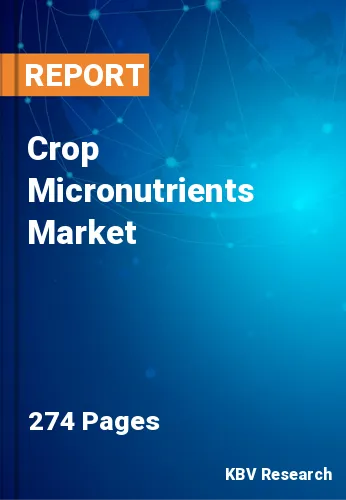The Global Crop Micronutrients Market size is expected to reach $8.7 billion by 2028, rising at a market growth of 7.5% CAGR during the forecast period.
Crop micronutrients are critical nutrients that plants need to develop and perform other metabolic functions. They help to improve quality, color, taste, fertilizer efficiency, disease resistance, water use, and other factors. These micronutrients also help in the creation of big and strong roots, as well as the formation of full proteins and chemicals and improved plant immunity. The crop micronutrients market is being driven by factors such as the efficacy of micronutrients for crop production and productivity, growing awareness among growers about the advantages of micronutrients, and shrinking agricultural land. Additionally, developing soil inadequacies in cultivated lands can be attributed to the increased demand for crop micronutrients. Crop micronutrients also help crops to be more resistant to disease.
Growing public awareness about food security, as well as rising occurrences of micronutrient deficiencies in soils around the world, are likely to drive market expansion over the forecast period. Rising investment by key participants in new product launches is projected to enhance industry sales even more.
Iron application has been linked to good yields, economic returns, and iron concentration in mungbean. Biofortification is a popular trend in the agricultural micronutrient industry, and it aids in the integration of nutrients into food crops. This method is gaining popularity as a cost-effective and sustainable strategy to boost mineral concentration in staple crops like mungbean. Increased iron levels in mungbean are bringing in more money for farmers and enhancing manufacturers' credibility in the agricultural micronutrient market. Manufacturers are increasing their iron compound production capacities because women and pre-school children are the most vulnerable to micronutrient deficiency.

Fertilizer application to crops is influenced by soil type, soil fertility levels among soil types, accessible nutrients ratios, type of crop, and weather conditions. The influence of the COVID-19 pandemic on soil fertility is due to human activity, such as farmers' failure to apply fertilizer on time. In the wake of the COVID-19 pandemic, there is a pressing need to expand existing measures to improve agricultural input use efficiency, particularly fertilizer, by implementing innovations like sensor and satellite technologies.
Crop micronutrients can be found in low concentrations in plants, and their deficiencies can cause crop diseases. Micronutrient shortages and imbalances are occurring in soils all around the world, and the main causes include temperature, humidity, and soil pH. The accessibility of micronutrients in the soil is reduced as the pH of the soil is raised. To alleviate the shortages, governmental and non-governmental organizations are emphasizing mineral fertilization measures. As per the FAO, countries like China, the United States, and India consume roughly half of all mineral fertilizer nutrients. Many countries have achieved national food sufficiency, nonetheless, there is always a need to feed people with nutrient-rich food by improving agriculture practices.
Owing to the different known risks of non-biodegradable chelating agents, the market is increasingly focusing on the creation of biodegradable chelates. In place of non-biodegradable agents, NTA, EDDS, and ITS are the most recently produced and extensively utilized agents on the market. These are mostly utilized for goals like removing metals that can harm plant and soil health, as well as preventing harmful metals from precipitating into the soil. Growers in the region are gradually transitioning away from commodity fertilizers and toward specialty fertilizers such as coated and encapsulated fertilizers, chelated fertilizers, and slow release fertilizers.
The trend in food consumption in industrialized countries is mostly changing toward better meals derived from healthy and safe sources. As a result, consumers are becoming more conscious of the commercialization of agriculture and the widespread use of chemical and synthetic fertilizers, both of which have the potential to harm human health. Due to this, in countries where food production outnumbers consumption, people are more concerned about the quality of their food. Organic fertilizers are witnessing huge demand, particularly in developed regions, with key markets including the United States, Germany, and France. As a result of the rising organic fertilizers, organic food production would rise in the coming years.

Based on Form, the market is segmented into Chelated and Non-Chelated. The non-chelated segment garnered a significant revenue share in the crop micronutrients in 2021. It is owing to the expansion of the agriculture sector across various nations. These non-chelated micronutrients are as useful as chelated forms since they provide boron, zinc, copper, and other elements to plants.
Based on Application, the market is segmented into Soil, Foliar, Fertigation, and Others. The soil application segment procured the maximum revenue share in the crop micronutrients market in 2021. The soil mode of application is a popular method for applying micronutrients in agriculture. This portion enables for equal distribution of micronutrients to plants using traditional fertilizer application equipment. Because of the various factors, soil mode of application is extensively employed in agriculture, and this segment is predicted to grow in the coming years.
Based on Crop Type, the market is segmented into Cereals & Grains, Pulses & Oilseeds, Fruits & Vegetables, and Others. The fruits & Vegetable segment procured a significant revenue share in the crop micronutrients market in 2021. It is owing to the rising demand for fruits among the population. The recent trend of rising fruit consumption has coincided with an increase in vegetable and fruit exports, resulting in a rise in the crop plantation area. Micronutrient-rich fruits and vegetables are likely to rise significantly in the next years.
Based on Type, the market is segmented into Copper, Zinc, Boron, Iron, Manganese, Molybdenum, and Others. The copper segment recorded the highest revenue share in the crop micronutrients market in 2021. Copper-type micronutrients catalyze processes in plants by activating enzymes necessary for protein synthesis. They also aid in the reduction of vitamin A production in plants, which would fuel the segment's expansion.
| Report Attribute | Details |
|---|---|
| Market size value in 2021 | USD 5.3 Billion |
| Market size forecast in 2028 | USD 8.7 Billion |
| Base Year | 2021 |
| Historical Period | 2018 to 2020 |
| Forecast Period | 2022 to 2028 |
| Revenue Growth Rate | CAGR of 7.5% from 2022 to 2028 |
| Number of Pages | 274 |
| Number of Tables | 489 |
| Report coverage | Market Trends, Revenue Estimation and Forecast, Segmentation Analysis, Regional and Country Breakdown, Companies Strategic Developments, Company Profiling |
| Segments covered | Form, Application, Crop Type, Type, Region |
| Country scope | US, Canada, Mexico, Germany, UK, France, Russia, Spain, Italy, China, Japan, India, South Korea, Singapore, Malaysia, Brazil, Argentina, UAE, Saudi Arabia, South Africa, Nigeria |
| Growth Drivers |
|
| Restraints |
|
Based on Regions, the market is segmented into North America, Europe, Asia Pacific, and Latin America, Middle East & Africa. The Asia Pacific emerged as a leading region in the crop micronutrients with the largest revenue share in 2021. It is due to the fact that most crop production is done in this region. The market for crop micronutrients is growing due to the rising demand for high-quality products and changing farming practices. The direct application of micronutrients for the treatment of plant shortages would bolster the industry's need even further.
Free Valuable Insights: Global Crop Micronutrients Market size to reach USD 8.7 Billion by 2028
The market research report covers the analysis of key stake holders of the market. Key companies profiled in the report include BASF SE, Compass Minerals International, Inc., The Mosaic Company, Nutrien Limited, DuPont de Nemours, Inc., Akzo Nobel N.V., Aries Agro Limited, Yara International ASA, Baicor, LLC, and Western Nutrients Corporation.
By Form
By Application
By Crop Type
By Type
By Geography
The global crop micronutrients market size is expected to reach $8.7 billion by 2028.
Rising deficiency of micronutrients in soil are driving the market in coming years, however, availability of various organic fertilizers growth of the market.
BASF SE, Compass Minerals International, Inc., The Mosaic Company, Nutrien Limited, DuPont de Nemours, Inc., Akzo Nobel N.V., Aries Agro Limited, Yara International ASA, Baicor, LLC, and Western Nutrients Corporation.
Yes, Due to COVID-19 there is a pressing need to expand existing measures to improve agricultural input use efficiency, particularly fertilizer, by implementing innovations like sensor and satellite technologies.
The Chelated segment acquired maximum revenue share in the Global Crop Micronutrients Market by Form in 2021, thereby, achieving a market value of $6.37 billion by 2028.
The Asia Pacific market dominated the Global Crop Micronutrients Market by Region in 2021, and would continue to be a dominant market till 2028; thereby, achieving a market value of $4.08 billion by 2028.
Our team of dedicated experts can provide you with attractive expansion opportunities for your business.

